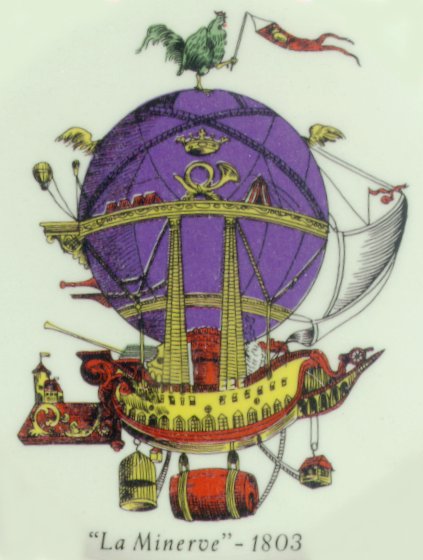A Tale of Two Balloons
Today, a tale of two balloons. The University of Houston's College of Engineering presents this series about the machines that make our civilization run, and the people whose ingenuity created them.
Here are two papers on long-range balloons. One's a monograph written in 1804. The other's a 1992 article in Mechanical Engineering -- 188 years later.
In 1804 a French physics professor, E.G. Robertson, proposed building an 80-ton balloon. The gondola doubles as an ocean-going ship for 60 scientists. They will make great voyages of exploration. They will "boldly go where no man has gone before."
Robertson had taken part in ballooning that'd been going on in Europe for two decades. He did early parachuting. Now he trashes the other early aeronauts. He is arrogant and combative.
Fantasy and good sense are all mixed up in his design. The gondola has seminar rooms and labs. Lady observers ride in a small separate gondola where they won't distract the scientists.
Everyone carries a parachute. There's even a little getaway balloon -- a kind of ship's longboat. Still, Robertson realizes that his balloon cannot be steered. It can only follow the wind. Steering will have to wait for engine-powered dirigibles.
Robertson never got to build his balloon. Now, two centuries later, we still haven't managed to balloon around the world. But read the 2nd paper:
Larry Newman and two friends are ready to try it. By the time you hear this program, you may already know if they made it. They plan to buoy seven miles into the sky above Reno, then ride the Westerlies at 75 miles an hour.
This balloon is Spartan alongside Robertson's. It's 1/8 the weight and 2/3 the diameter. But some features have been added in 188 years. For ballast it has a second balloon, just as large, below the gondola. It carries cool air. Since the ballast is only air, they can renew it in mid-flight.
They'll ride in a pressurized cabin. They'll carry a cryogenic tank to resupply the helium gas. They have cameras and communications systems -- complex valves and pumps.
This balloon benefits from one more thing that Robertson lacked. It reflects respect -- for the danger, for the complexity, and for the past. Maybe they'll do what Robertson couldn't.
The musical, Man of La Mancha, has a curious interlude. Don Quixote's priest muses about Quixote's mad dream -- of honor -- of the Lady Dulcinea. The dream, says the Padre, is only flame and air, but we're really lost only if we stop chasing it.
Robertson's balloon -- his dream, his Dulcinea -- was named Minerve. The new balloon is called Earthwinds Hilton. They are very different machines. But they hold one element in common -- and that is Quixote's flame and air.
I'm John Lienhard, at the University of Houston, where we're interested in the way inventive minds work.
(Theme music)
Robertson, E.G., La Minerve. Paris: S.V. Degen, 1804.
Ashley, S., Around the World in a Dozen Days? Mechanical Engineering, Vol. 114, No.12, Dec. 1992, pp. 46-49.
I'm grateful to Jeff Fadell, UH Library, for translating the Robertson monograph; and to Nancy Boothe, Head of The Woodson Research Library at Rice University, for leading me to this rare book in the Benjamin Monroe Anderson Collection on the History of Aeronautics.

An image of the fictional Minerve balloon from an antique French plate